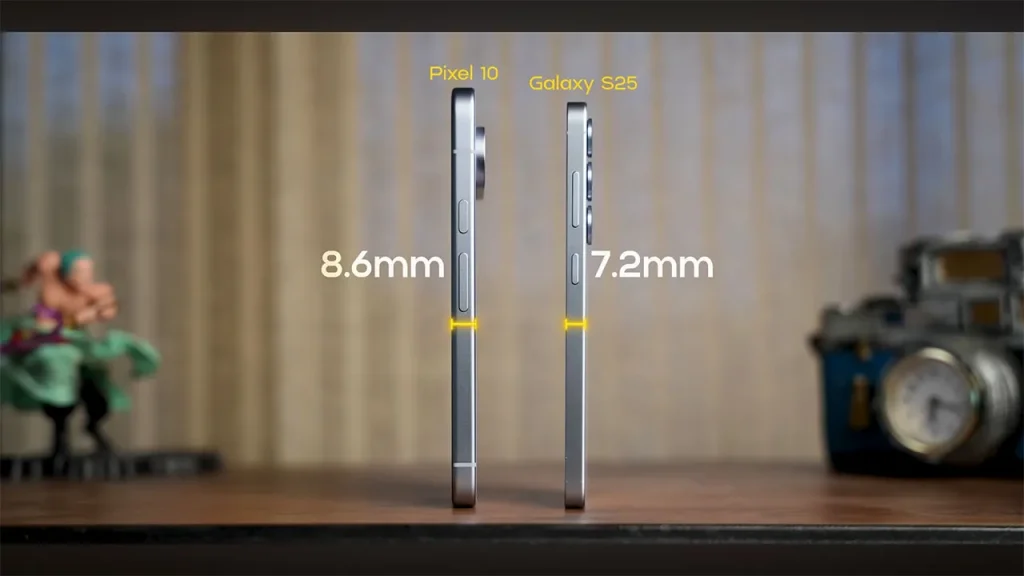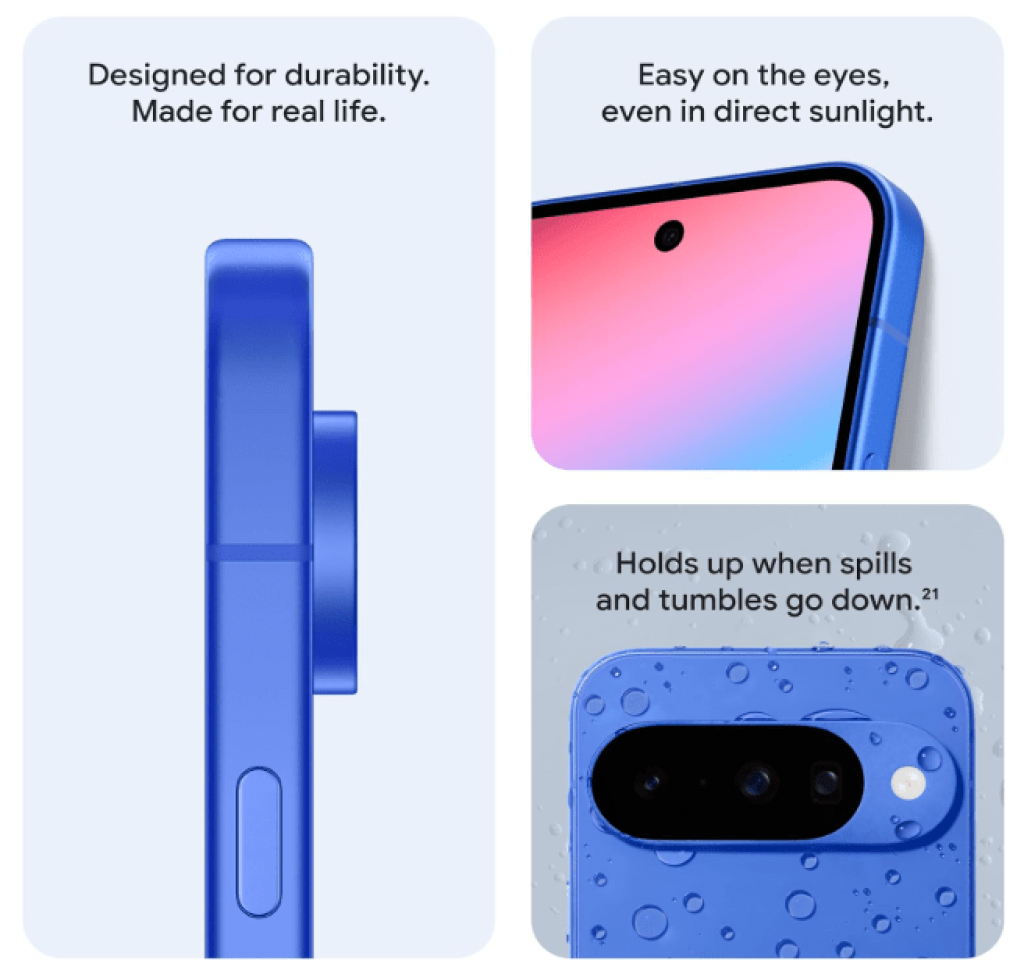
We’ve finally reached the culmination of Google’s 10-year smartphone journey. The Pixel 10 is here, bringing with it a slew of features that many of us are sure will be a boon for the future. But the most important thing is that Google has shown from the start, with its AI everywhere slogan, that this phone isn’t just new hardware, but a complete platform for AI.
In our Google Pixel 10 review, we’re going to take a look at the Pixel 10 from every angle. From its exterior design to its hardware specs, its weird camera, and of course, its value for money, which is always a complicated debate.
Google Pixel 10
The phone that puts AI at the center of the user experience
📱 Design & Build
Similar design to previous generation (Pixel 9) with distinctive horizontal camera bar and rounded edges for comfortable grip
Colors: Obsidian (black), Indigo (purple-blue), Frost (light blue), Limoncello (light yellow)
📺 Display
🔋 Battery & Charging
Battery Life: 1.5 to 2 days of normal use or 33 hours of heavy use
📸 Camera
Triple Camera System: First time in base model
- Main lens: 48MP
- Ultra-wide lens: 13MP
- Telephoto lens: 5x optical zoom
- Camera Coach: Guidance for better photography
- Best Group Shot: Combines best frames for group photos
- Pro Res Zoom: Restores details at high zoom (up to 20x)
⚙️ Hardware
Processor: Tensor G5 made by TSMC with 3nm process
34-38% performance improvement over previous generation
Note: Processing power lower than flagship Android competitors
💻 Software & UI
Operating System: Android 16
AI Features:
- Magic Cue: Smart assistant running in background
- Circle to Search: Search by circling on screen
- Live Translate: Real-time translation of phone conversations
✅ Strengths
- Triple camera with true telephoto lens in base model
- Excellent and practical AI capabilities
- Very bright and high-quality display
- Unparalleled 7-year software support
- Acceptable battery life thanks to optimized chip
- Distinctive and recognizable design
❌ Weaknesses
- Weaker processing hardware than flagship competitors
- Reduction in main and ultra-wide camera sensor quality
- High price due to unofficial imports
- No official warranty and after-sales service
- Registry risk: US-specific models only support eSIM
- Slower charging speed than competitors
Final Verdict
The Google Pixel 10 is a phone that puts artificial intelligence at the center of the user experience. While it may lag behind some Android competitors in terms of raw hardware power, its focus on optimization, software, and unique AI capabilities delivers a seamless and distinctive user experience.
This phone is excellent for those looking for the latest Google features, pure Android experience, and advanced AI, but users who need official warranty, after-sales service, and maximum processing power for heavy gaming might find better options on the market.
Final Recommendation
The Pixel 10 is a special phone for special people. If you’re looking for raw power, consider other options like the Galaxy S25. But if endless intelligence and seamless software experience are your priorities, the Pixel 10 is a unique choice.
If you’re a longtime Pixel fan, the first time you see the Pixel 10 will feel familiar. Why? Because Google has decided to reuse the design of the previous generation, the Pixel 9, and there aren’t many big changes in this area. The same horizontal camera strip that divides the back of the phone into two parts and the rounded edges of the phone that make it fit comfortably in the hand are still in place. This special design makes the Pixel 10 stand out from the rest of the phones on the market, which all look the same, and it is easily recognizable from the back.
But how is its build quality? In this regard, the Pixel 10 is a true flagship phone. Both the back and front of the phone are protected by durable Gorilla Glass Victus 2 and a matte aluminum frame is placed around it, which gives the user the feeling of an expensive phone. In addition, like most flagships on the market, the Pixel 10 is IP68 certified, which means it can survive up to 1.5 meters of water for 30 minutes and is also resistant to dust. This means you no longer have to worry about a sudden rain or dropping the phone in the water.
10 uses of Samsung’s artificial intelligence
One of the most attractive parts of this phone is its new colors. Unlike the Pro models, which have classic and matte colors, the Pixel 10 has come to the market with special and vibrant colors. Obsidian (black), Indigo (purple blue), Frost (light blue), and Limoncello (light yellow) colors that give the phone a special atmosphere and leave the user’s hand open to choice.
Google Pixel 10 screen review
When you turn on the phone, the 6.3-inch OLED display with a refresh rate of 120 Hz on the Pixel 10 really catches your eye. With a resolution of 1080 x 2424 pixels and a pixel density of 422 pixels per inch, this display displays images with excellent quality and high detail, and scrolling through its user interface feels smooth and attractive.
The most important strength of this screen is its extraordinary brightness. With a brightness of 2000 nits in HDR mode and a maximum of 3000 nits in peak mode, this phone is brighter than competitors like the Galaxy S25 and iPhone 16. This means that even on the brightest and sunniest days, you can see the content on your phone without any problems.
But there is a small drawback that may not be important to many, but is important to tech professionals. Unlike most flagships and even its rival Galaxy S25, the Pixel 10 cannot lower the screen refresh rate to 1Hz. This means that when the screen is on and fixed (for example, in Always-On Display mode), its battery consumption is higher than that of its competitors. This shows that Google has not yet caught up with Samsung in some details.
Another interesting point in this section is a new feature that Google has added for users whose eyes are sensitive to PWM flicker. PWM, or Pulse Width Modulation, is the technique that OLED displays use to control brightness and can cause headaches and eye fatigue for some. Google has increased the rate of this flicker from 240 to 480Hz by adding an option in the settings to make it less annoying for sensitive eyes. Although it still doesn’t reach the level of other phones like the OnePlus 13 with a 2160 Hz rate, the fact that Google has paid attention to this issue is a step towards excellence.
Google Pixel 10 Battery Review
If you’re a long-time Pixel fan, you’re probably familiar with the Pixel’s poor battery life. But the Pixel 10 is a different story. It comes with a 4,970mAh battery, which may be just 3% larger than the Pixel 9’s 4,700mAh, but it’s a huge improvement in performance.
This is where Google’s hardware and software magic really shines. The new Tensor G5 chip, now made by TSMC instead of Samsung and using a 3nm process, is both more powerful and more efficient. This optimization significantly reduces the phone’s battery life, making that small increase in capacity a big deal. In our tests, the Pixel 10 managed to last for 1.5 to 2 days of normal use, or about 33 hours of heavy use, which includes 7 hours of screen-on time and 5 hours of 5G internet use. This performance is very good considering the battery capacity and shows that the Pixel 10 is no longer weak in terms of battery life.
CMF Phone 2 Pro Gaming Review: A Mid-Range mobile
But when it comes to charging, Google is still lagging behind its competitors. The Pixel 10 supports 30W wired fast charging, which can charge the battery up to 55% in 30 minutes. It also supports Qi2 wireless charging at a speed of 15W. While these speeds are sufficient for everyday use, when you compare them to competitors like the Galaxy S25, you will notice that the Pixel’s charging speed is much slower.
But there is a hidden feature in this section that may not be noticeable, but is very useful. The Pixel 10 supports Qi2 wireless charging and has built-in magnets called Pixelsnap. This feature makes the phone compatible with all magnetic accessories like Apple’s MagSafe, and you don’t need a special case or cover. Just place the phone on the magnetic charger and it will automatically lock into place to charge. This feature is a huge competitive advantage for the Pixel and could create an attractive ecosystem of accessories for Google.
Google Pixel 10 Camera Review
This is the most interesting and, of course, the most complicated part of the review. The camera has always been the main strength of Pixel phones, and Google has really improved it this year. But there is also something strange happening in its hardware that needs to be mentioned.
The big news is that the base model of the Pixel 10 is finally equipped with a triple camera system. In addition to the main and ultra-wide lenses, a telephoto lens with 5x optical zoom has been added, which allows you to take pictures of distant subjects.
But here’s where the story gets a little strange. In order to fit the telephoto lens into this phone, Google has made the main lens sensors (from 50 megapixels to 48 megapixels) and the ultrawide (from 48 megapixels to 13 megapixels) smaller and reduced their quality. This decision has caused quite a stir. This move by Google to add a telephoto lens sacrifices its main strength, which is the quality of photography with the main lens and ultrawide.
This may seem strange and annoying at first glance, but for the average user, having a telephoto lens with real optical zoom can be much more valuable than having a sensor with higher megapixels in the main lens. This strategy makes the base model of the Pixel 10 have the full capabilities of a flagship phone for the first time and the user does not need to go to the Pro models for real zoom. This decision shows that Google is making the line between the base model and the Pro models clearer and perhaps preparing itself to eliminate or dilute the budget A series.
As we know, the real power of the Pixel isn’t in its hardware, but in its software, algorithms, and AI magic. With the Pixel 10, that magic has reached its peak, and Google has introduced new features that are truly game-changing:
- Camera Coach: This feature uses Gemini AI to analyze the scene and tell you how to take a better photo. For example, it suggests lowering the camera a little for a better angle, or getting closer to the subject for better framing.
This feature has been improved and now works automatically. The Pixel 10 can analyze 150 frames in a matter of seconds and select the best ones to combine them to give you a perfect group photo with everyone’s eyes wide open and their lips smiling. This begs the question: Are these features creating images that never actually happened? It’s a fascinating philosophical debate that will shape the future of photography. Pro Res Zoom: This feature uses generative AI to restore and sharpen details that are lost at very high zoom levels. The Pixel 10 can zoom in up to 20x, and the Pro models can zoom in up to 100x. Of course, this feature is currently only used for stationary subjects like buildings or cars, as generative AI still can’t reproduce human faces completely naturally, and there are still some bugs.
Google Pixel 10 Hardware Review
The biggest upgrade in the Pixel 10 is its Tensor G5 chip. Google has finally parted ways with Samsung and is now using the world’s best chipmaker, TSMC, to make this chip. This change has resulted in the Tensor G5 being a significant 34-38 percent improvement over its predecessor (G4) and performing very fast and smoothly. In benchmarks, the Tensor G5 even outperforms the Snapdragon 835 (3rd generation).Redmi Note 14 Pro 4G Review: Xiaomi’s Mid-Range Beast?
But to be honest, this chip is still a long way from the strongest Android competitor, the Snapdragon 835 Elite, which is used in the Galaxy S25 Ultra. In AnTuTu tests, the Snapdragon 835 Elite scored more than twice as much as the Tensor G5, and it also outperformed the Pixel in Geekbench’s single-core and multi-core tests.
But that doesn’t mean the Pixel is weak. Google’s philosophy is to focus on optimization and AI rather than raw processing power for heavy gaming. In everyday use, the Pixel 10 is quite fast and smooth, and has no problems opening apps or browsing the web. But if you’re a serious gamer looking for the best frame rates in games, there may be other options on the market with more powerful graphics that are more suitable for you. Google also solved the problem of the phone overheating during heavy tasks by using a larger vapor chamber.
Google Pixel 10 UI Review
The Pixel 10 comes with Android 16 out of the box, and one of its biggest advantages is long-term software support. Google has promised to release software and security updates for this phone for up to 7 years. This means that if you buy this phone today, your software will always be up to date and you can rest assured in terms of security. This is a huge competitive advantage that even Apple hasn’t officially promised.
But the Pixel 10’s software appeal isn’t just about its updates, but also its exclusive AI features that transform the user experience:
- Magic Cue: This feature is like a smart assistant that’s always active in the background and actively helps you. For example, if you’re calling a company, Magic Cue will automatically find order information from your email and display it on the screen for easy access. This feature only works in Google apps to protect your privacy and keep your information on your phone.
Circle to Search: This popular feature, which was previously on the Pixel 9, lets you draw a circle around anything you see on the screen and Google will find related information for you. - Live Translate: Live translation of phone conversations while preserving the natural voice of the speaker is another cool feature that makes talking to strangers much easier. Many of these exclusive Pixel AI features run locally on the phone itself with Gemini Nano models. This means your personal information is not sent to Google servers and your privacy is completely preserved. While some Pixel features like Magic Eraser have been unofficially ported to other phones in the past, new features like Magic Cue that work with the user’s personal information are not easily copied, which makes the Pixel 10 even more valuable.
Google Pixel 10 Speaker Review
The Pixel 10 uses stereo speakers that have improved sound quality, especially in the bass section. These speakers do a great job for watching movies and listening to music, and give you an enjoyable audio experience. Of course, like most flagships, the 3.5mm headphone jack has been removed and you will have to use wireless headphones or a converter.

Is the Google Pixel 10 worth buying?
Now we come to the hardest part. Considering everything we have said, is the Pixel 10 worth buying in the market at a price of about 100 million Tomans?
This phone has a number of key strengths and weaknesses that you should pay attention to when buying:
Pixel 10 strengths:
- Triple camera with a true telephoto lens in the base model
- Excellent and practical AI capabilities
- Very bright and high-quality screen
- Unparalleled 7-year software support
- Acceptable battery life thanks to an optimized chip
Pixel 10 weaknesses: - Weaker processing hardware than flagship competitors
- The issue of the backward compatibility of the main camera sensors
- High price due to unofficial imports
- No official warranty and after-sales service
- Registry risk: US-specific models only support eSIM and do not take a physical SIM card.
- Versus Galaxy S25: Pixel has the edge in AI and natural photography, but Galaxy S25 has much higher raw processing power Versus iPhone 17: iPhone 17 finally brings 120Hz display to the base model and is excellent in terms of ecosystem and processing power. But Pixel is a serious competitor with its focus on AI and its base price that is lower than iPhone.
Who is Pixel 10 good for?
If you are a true technology lover and you care about having the purest Android experience, using the latest Google AI features, and are willing to accept the risk of price and no warranty, Pixel 10 is a great option.
But if you are a gamer, or after-sales service and warranty are very important to you, or you are looking for the highest purchase value, you should consider other options on the market like Galaxy S25 series or even iPhone 17 series. Pixel 10 is a special phone made for special people. While it may lag behind its competitors in terms of raw hardware, with the magic of AI and software, it gives you a unique user experience that you won’t find on any other phone. The choice is yours whether you’re looking for raw power or endless intelligence.



